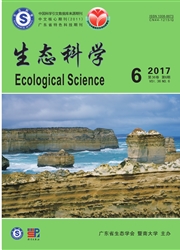

 中文摘要:
中文摘要:
阿拉善沙地飞播植被的形成和发育与生长季中的降水量及其季节分配有关。调查结果表明,当播种时月降水量大于65mm时,植物群落中高或较高存在度的植物种是蒙古沙拐枣(Calligonum mongolicum)、沙鞭(Psammochloa villose)和白沙蒿(Artemisia sphaerocephala),重要值分别是64.9%、61.6%3123.7%,生物量2038.2kg·hm^-2。飞播种时月降水量小于40mm时,植物群落中高的或较高存在度的种是白沙蒿、葡根骆驼蓬(Peganum nigellastrum),重要值依次是65.5%~66.6%、35.7%~46.1%,生物量182713~1834.7kg·hm^-2。飞播植物群落种的数量随生长季节的变化而异,在6~9月,白沙蒿的重要值和生物量所占群落总量的比率逐月增多,种的存在度保持稳定,表现了较强的适应能力。蒙古沙拐枣的重要值和生物量在6~8月间表现出增长趋势,9月生物量有所减少,但其在植物群落中的表现相对比较稳定。沙鞭的重要值和生物量随季节变化而减少,表现出衰退趋势。以上结果表明,在沙地人工建植白沙蒿和蒙古沙拐枣是治理退化沙地的有效措施。
 英文摘要:
英文摘要:
The formation and evolution of vegetation sowed by airplane in the Alxa Desert is closely related to the amount and distribution of rainfall in growing season. The results in this study showed that the percentages of callogonum mongolicu, Psammochloa mogolica and Artemis& sphaerocephala in this area were higher than other species when the monthly rainfall is more than 65 mm during planting period. Furthermore, the important values were 64.5%, 61.59% and 23.67% respectively and the biomass was 2038.20 kg/hm2. The percentages of Artemisia aphaeocephala and Peganum nigellastrum in this area were higher than other species when the monthly rainfall is less than 40mm during planting period. Their important value were 65.51% to 66.58% and 35.71% to 46.11% respectively and the biomass was 1827.30 to 1834.65 kg/hm2. In additionally, species richness also varied with different seasons in this area. The important value and the biomass ofA. sphaerocephala increased, but the percentages ofA. sphaerocephala were stable, which indiacted that A. sphaerocephala were adaptable during growing season, from June to September. For Calligonum mongolicum, the important value and biomass increased from June to August, but decreased in September. However, it is relatively stable among all species. The biomass and the important value of P mogolica decreased with seasons, which indicated the degradation of P mogolica . Above results showed that planting Artemisia sphaerocephala and calligonum mogolica is an effective measure for controlling degradation in the Alxa Desert.
 同期刊论文项目
同期刊论文项目
 同项目期刊论文
同项目期刊论文
 期刊信息
期刊信息
